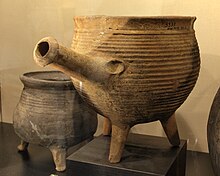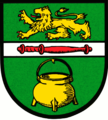
Pottery is the process and the products of forming vessels and other objects with clay and other raw materials, which are fired at high temperatures to give them a hard and durable form. The place where such wares are made by a potter is also called a pottery. The definition of pottery, used by the ASTM International, is "all fired ceramic wares that contain clay when formed, except technical, structural, and refractory products". End applications include tableware, decorative ware, sanitaryware, and in technology and industry such as electrical insulators and laboratory ware. In art history and archaeology, especially of ancient and prehistoric periods, pottery often means vessels only, and sculpted figurines of the same material are called terracottas.

A cauldron is a large pot (kettle) for cooking or boiling over an open fire, with a lid and frequently with an arc-shaped hanger and/or integral handles or feet. There is a rich history of cauldron lore in religion, mythology, and folklore.

Cookware and bakeware is food preparation equipment, such as cooking pots, pans, baking sheets etc. used in kitchens. Cookware is used on a stove or range cooktop, while bakeware is used in an oven. Some utensils are considered both cookware and bakeware.

Outdoor cooking is the preparation of food in the outdoors. A significant body of techniques and specialized equipment exists for it, traditionally associated with nomadic cultures such as the Berbers of North Africa, the Arab Bedouins, the Plains Indians, pioneers in North America, and indigenous tribes in South America. These methods have been refined in modern times for use during recreational outdoors pursuits, by campers and backpackers.

Bolesławiec is a historic city situated on the Bóbr River in the Lower Silesian Voivodeship, in western Poland. It is the administrative seat of Bolesławiec County, and of Gmina Bolesławiec. As of June 2021, it has a population of 38,280. Founded in the 13th century, the city is known for its long-standing pottery-making tradition and heritage Old Town.
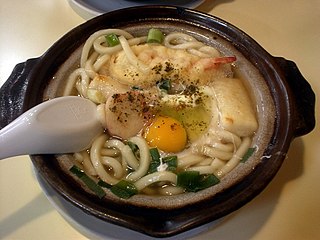
Donabe are pots made out of a special clay for use over an open flame in Japanese cuisine, and in the case of semi-stoneware Banko ware of high petalite content. Often, the food is cooked at the table on a gas burner for various nabemono dishes such as shabu-shabu and dishes served simmering including nabeyaki udon. They are sized by sun, one of the Japanese units of measurement.
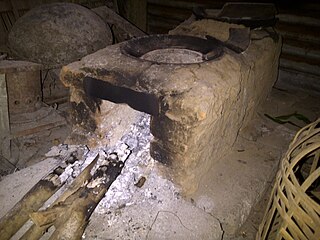
A stove or range is a device that burns fuel or uses electricity to generate heat inside or on top of the apparatus, to be used for general warming or cooking. It has evolved highly over time, with cast-iron and induction versions being developed. Stoves can be powered with many fuels, such as electricity, gasoline, wood, and coal.

A mess kit is a collection of silverware and cookware designed for use by military personnel for food and military rations. They may also be used during camping and backpacking. There are many varieties of mess kits that militaries issue to their personnel that later become available to consumers.

Heavy-duty cookware made of cast iron is valued for its heat retention, durability, ability to maintain high temperatures for longer time duration, and non-stick cooking when properly seasoned. Seasoning is also used to protect bare cast iron from rust. Types of cast iron cookware include frying pans, dutch ovens, griddles, waffle irons, flattop grills, panini presses, crepe makers, deep fryers, tetsubin, woks, potjies, and karahi.

A tea set or tea service is a collection of matching teaware and related utensils used in the preparation and serving of tea. The traditional components of a tea set may vary between societies and cultures.
A fire pot is a container, usually earthenware, for carrying fire. Fire pots have been used since prehistoric times to transport fire from one place to another, for warmth while on the move, for cooking, in religious ceremonies and even as weapons of war.
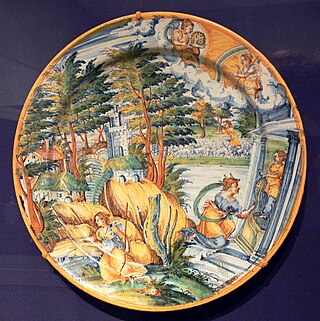
Tin-glazed pottery is earthenware covered in lead glaze with added tin oxide which is white, shiny and opaque ; usually this provides a background for brightly painted decoration. It has been important in Islamic and European pottery, but very little used in East Asia. The pottery body is usually made of red or buff-colored earthenware and the white glaze imitated Chinese porcelain. The decoration on tin-glazed pottery is usually applied to the unfired glaze surface by brush with metallic oxides, commonly cobalt oxide, copper oxide, iron oxide, manganese dioxide and antimony oxide. The makers of Italian tin-glazed pottery from the late Renaissance blended oxides to produce detailed and realistic polychrome paintings.

A kitchen utensil is a small hand-held tool used for food preparation. Common kitchen tasks include cutting food items to size, heating food on an open fire or on a stove, baking, grinding, mixing, blending, and measuring; different utensils are made for each task. A general purpose utensil such as a chef's knife may be used for a variety of foods; other kitchen utensils are highly specialized and may be used only in connection with preparation of a particular type of food, such as an egg separator or an apple corer. Some specialized utensils are used when an operation is to be repeated many times, or when the cook has limited dexterity or mobility. The number of utensils in a household kitchen varies with time and the style of cooking.
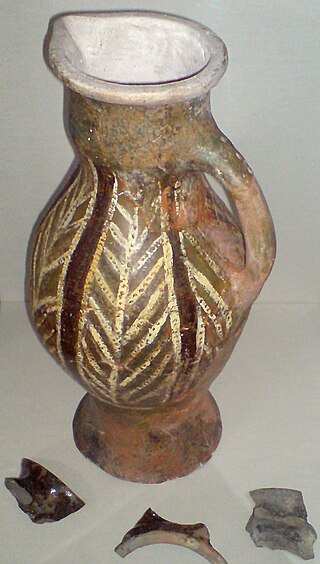
Deritend ware is a distinctive style of medieval pottery produced in Birmingham, England in the twelfth and thirteenth centuries. There are three types of Deritend ware; a fine to moderately sandy, micaceous orange to red ware, used mainly for jugs, with some examples of bowls, dripping trays and aquamaniles, dating to the 13th to early 14th centuries; a black or, less frequently, grey ware with a brown core, also micaceous, used mainly for cooking pots/jars and less commonly for large unglazed jugs and skillets/pipkins, dating from possibly the late 12th century to the early 14th century; and a sandy brown ware with grey core used for cooking pots, dating from possibly the late 12th century to 13th century. Wasters i.e. pottery misfires have been found for all three wares in Birmingham. Glazed Deritend ware jugs were decorated with white slip lines and applied white clay strips, often roller stamped, and white clay pads, The more complex decorative schemes are in the North French style ; the decorated jugs closely resemble London-type ware and it is distinctly possible that the Deritend ware industry included migrant potters from the London area in the thirteenth century.

A thermal cooker, or a vacuum flask cooker, is a cooking device that uses thermal insulation to retain heat and cook food without the continuous use of fuel or other heat source. It is a modern implementation of a haybox, which uses hay or straw to insulate a cooking pot.

Ceramic art is art made from ceramic materials, including clay. It may take varied forms, including artistic pottery, including tableware, tiles, figurines and other sculpture. As one of the plastic arts, ceramic art is a visual art. While some ceramics are considered fine art, such as pottery or sculpture, most are considered to be decorative, industrial or applied art objects. Ceramic art can be created by one person or by a group, in a pottery or a ceramic factory with a group designing and manufacturing the artware.

Surrey whiteware or Surrey white ware, is a type of lead-glazed pottery produced in Britain from the 13th to the 16th centuries. The white-fired sandy earthenware was produced largely from kilns in Surrey and along the Surrey-Hampshire border. Surrey whitewares were the most commonly used pottery in London during the late medieval period. There are four classes of Surrey whiteware: Kingston-type, Coarse Border ware, Cheam whiteware and Tudor Green ware.

Border ware is a type of post-medieval British pottery commonly used in the South of England, London and then later in the early American colonies beginning in the sixteenth and ending in the nineteenth century with a height of popularity and production in the seventeenth century. The lead-glazed, sandy earthenware was produced from kilns along the border between Hampshire and Surrey. There are two classes of Border ware, fine whitewares and fine redwares.

Shelly-sandy ware(SSW) is a type of medieval pottery produced in Great Britain. The pottery fabric is tempered with both sand and shell, most commonly quartz sand and ground-up shell. The fabric is generally dark grey in colour with brown oxidised surfaces. SSW was typically handmade until the potters transitioned to wheel-thrown pottery production. The pottery was manufactured and distributed primarily from 1140—1220 AD in the Greater London area.
